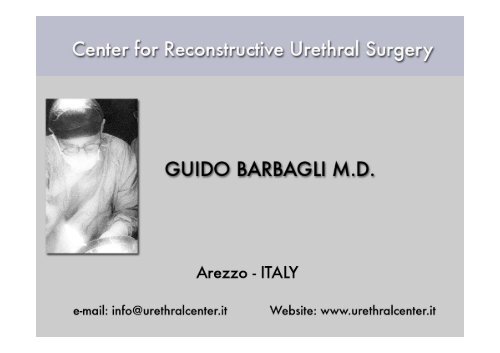Failed hypospadias repair presenting in adults - Urethral Center
Failed hypospadias repair presenting in adults - Urethral Center
Failed hypospadias repair presenting in adults - Urethral Center
- No tags were found...
You also want an ePaper? Increase the reach of your titles
YUMPU automatically turns print PDFs into web optimized ePapers that Google loves.
1 st Oceana Paediatric Urology CourseValencia – Spa<strong>in</strong>1 – 2 April 2011
<strong>Failed</strong> <strong>hypospadias</strong> <strong>repair</strong><strong>present<strong>in</strong>g</strong> <strong>in</strong> <strong>adults</strong>Why?
<strong>Failed</strong> <strong>hypospadias</strong> <strong>repair</strong>How often it is?“ Strictures <strong>in</strong> <strong>adults</strong> who had a<strong>hypospadias</strong> <strong>repair</strong> is a grow<strong>in</strong>g<strong>in</strong>dustry ”Andrich DE and Mundy AR, Eur Urol 2008; 54: 1031-1041
J Urol 2010; 183: 207-211211
The study is a retrospective observational analysisof the patient chart of those who were treated for failed<strong>hypospadias</strong> <strong>repair</strong> <strong>in</strong> 2 centers from 1988 to 2007223 patientsThe <strong>Center</strong> forReconstructive<strong>Urethral</strong> SurgeryArezzo - Italy1176 patients953 patientstThe UniversityChildren’sHospitalBelgrade - SerbiaUrol Int 2010; 85: 427-435
Patients with urethral stricture diseases: 1510<strong>Failed</strong> <strong>hypospadias</strong> <strong>repair</strong>: 223 (14.7%)J Urol 2010; 183: 207-211211
Patients t with penile urethral stricture t diseases: 437<strong>Failed</strong> <strong>hypospadias</strong> <strong>repair</strong>: 223 (51%)J Urol 2010; 183: 207-211
Age range <strong>in</strong> 1176 patientsage (years)N. patients1 – 16 250 (21.2%)17 – 20 451 (38.4%)21 – 40 358 (30.5%)41 – 60 112 (9.5%)>60 5(04%)(0.4%)< 16 years 250 (21.2%)> 16 years 926 (78.8%)J Urol 2010; 183: 207-211
Site of primary <strong>hypospadias</strong> <strong>in</strong> 1176 patientsglandular : 193 (16.4%)penile : 702 (59.7%)peno-scrotal: 281 (23.9%)J Urol 2010; 183: 207-211
Number of operations to <strong>repair</strong> primary<strong>hypospadias</strong> <strong>in</strong> 1176 patientsN. operations N. patients1 130 (11.1%)2 347 (29.5%)3 320 (27.2%)4 159 (13.5%)5 108 (9.2%)> 5 112 (9.5%)m<strong>in</strong>imum: 1 maximum: 23 median: 3J Urol 2010; 183: 207-211
Number of operations to <strong>repair</strong> complicationsfollow<strong>in</strong>g primary <strong>hypospadias</strong> <strong>repair</strong> <strong>in</strong> 1176patientsN. operations N. patients1 760 (64.6%) 6%)2 280 (23.8%)3 82 (6.9%)4 31 (2.7%)5 9 (0.8%)> 5 14 (1.2%)m<strong>in</strong>imum: 1 maximum: 8 median: 2J Urol 2010; 183: 207-211
Total number of operations to <strong>repair</strong> primary<strong>hypospadias</strong> <strong>repair</strong> and complications <strong>in</strong> 1176patientsN. operations N. patients2 102 (8.7%)3 289 (24.6%)4 369 (31.4%)5 – 10 311 (26.4%)11 – 20 91 (7.7%)> 20 14 (1.2%)m<strong>in</strong>imum: 2 maximum: 23 median: 5J Urol 2010; 183: 207-211
In conclusion, 1176 patients underwent a median of5 surgical operations to <strong>repair</strong> primary and failed<strong>hypospadias</strong>No other congenital abnormality of the body requires a median of 5surgical operations to be cured
Our experience <strong>in</strong> 1176 patients showed two different populations <strong>in</strong>which attempts at <strong>hypospadias</strong> surgical correction failed
Patients show<strong>in</strong>g penile deformity caused by:‣ Error <strong>in</strong> evaluation‣ Error <strong>in</strong> design‣ Error <strong>in</strong> surgical technique‣ Error <strong>in</strong> postoperative care
Patients show<strong>in</strong>g a satisfactory f<strong>in</strong>al outcomehav<strong>in</strong>g:• Cosmetically acceptable meatus• No evident penile deformitiessuch as fistula or chordee• <strong>Urethral</strong> stricture
Why ?
The neo-urethra I construct <strong>in</strong> the child willfollow the growth of the penis <strong>in</strong>to adulthood ?
Have you ever seen an ant become an elephant ?18 months old 18 years old
The normal urethra is a spongiosum-made urethra
The urethra <strong>in</strong> the patient who underwent <strong>hypospadias</strong>reconstruction is a sk<strong>in</strong>-made urethra
What is the the difference betweenthe spongiosum-made made urethra andthe sk<strong>in</strong>-made urethra?
As far as ur<strong>in</strong>ary function is concerned, the reconstructedsk<strong>in</strong>-made urethra is able to work as a normalspongiosum-made urethraPediatric surgeons andparents are very satisfiedwith the outcome…….
….but, unfortunately, the urethra is a part of the penis……and when children reach full sexual maturity, problems come …
…and the sk<strong>in</strong>-made urethra over time will beKO!
Why ?
The sk<strong>in</strong>-made urethra is not surrounded by the soft, wellvascularized corpus spongiosum …
… and this sk<strong>in</strong>-made urethra does not tolerate the repeatedmechanical stretch and trauma dur<strong>in</strong>g erection and sexual activity
Dur<strong>in</strong>g sexual activity, the corpus spongiosum is to the urethra whatthe airbag is to the body dur<strong>in</strong>g a car accident
The lack of spongiosum tissue promotes urethral deteriorationover time
<strong>Failed</strong> <strong>hypospadias</strong> p <strong>repair</strong> <strong>in</strong> adult populationpFuture objectives
Future objectives 1• To <strong>in</strong>vestigate the true epidemiology and <strong>in</strong>cidenceof failed <strong>hypospadias</strong> <strong>repair</strong> <strong>in</strong> adult population.• The collaboration between pediatric surgeons andurologits is a foundamental step.
In order to collect epidemiological data, pediatric surgeons are<strong>in</strong>vited to search and publish the long-term results (> 20 years) of<strong>hypospadias</strong> surgery performed <strong>in</strong> their hospitals.
Future objectives 2• To better stardardize the use of the current surgicaltechniques and the use of oral mucosa.• To develop new surgical ltechniques us<strong>in</strong>g tissueeng<strong>in</strong>eered material.
Future objectives 3To develop a validated d questionnaires i to <strong>in</strong>vestigate i thepatient reported outcome <strong>in</strong> adult patients treated forfailed <strong>hypospadias</strong> <strong>repair</strong>.
Future objectives 4To organize, <strong>in</strong> any country, meet<strong>in</strong>g and round tableson these topics, <strong>in</strong>volv<strong>in</strong>g all surgeons work<strong>in</strong>g <strong>in</strong>primary <strong>hypospadias</strong> <strong>repair</strong> and failed hypospadis<strong>repair</strong>.
Second European Conference on<strong>Failed</strong> Hypospadias RepairSeptember 22 - 2012Arezzo - Italy








